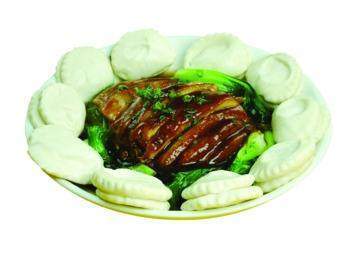Hyperlipidemia is the “disease of affluence” in today’s society. In recent years, with the continuous improvement of people’s living standards and the gradual improvement of lifestyle, the incidence of hyperlipidemia is also gradually increasing. Hypertension, hyperlipidemia, and hyperglycemia often visit middle-aged and elderly people. How should we adjust our diet to deal with these three highs? Today, the editor will introduce a dietary therapy for lowering blood lipids.
Lotus Leaf Rice Meat
Lotus leaf is the dried mature or semi-mature dry fan-shaped leaf of the plant Nelumbo nucifera. All parts of Nelumbo nucifera, such as lotus flesh, lotus heart, lotus root, lotus seed, and lotus root, can be used for medicine or dietary therapy, and lotus leaf is no exception. Modern pharmacological research and clinical practice have shown that lotus leaf contains lotus leaf alkaloids, demethylated lotus leaf alkaloids, yohimbine, papaverine, lotus glycoside, malic acid, tartaric acid, oxalic acid, gluconic acid, succinic acid, tannic acid, etc., which have excellent effects in lowering blood lipids.
The preparation method of lotus leaf rice meat is relatively simple. Use 5 large lotus leaves (cut into 10 pieces) and wash them thoroughly. If using dried leaves, soak them in boiling water until soft. Cut 250g of lean pork and 250g of rice (first ground into coarse sand). Slice the meat thinly, add 15g of soy sauce, a suitable amount of salt, a little starch, and a small amount of cooking oil, mix well. Then wrap the prepared meat slices and rice sand in lotus leaves to form elongated shapes, place in a steamer and steam for about half an hour before serving. By this time, the fragrance of the lotus leaf has permeated the rice meat, making it aromatic and delicious. This is the amount for a week, take one-third of it at lunch every other day, and continue for two weeks. After the treatment period, pause for several days, recheck the blood lipids. If the blood lipids have decreased but have not reached normal levels, continue the treatment. If the decrease in lipid values is minor, adjust the duration of each treatment period accordingly. If the decrease is significant, the treatment period can be shortened.
In addition to this dietary therapy, below are some ingredients for lowering blood lipids that you can consume regularly:
Multi-flower honey is a good ingredient in life. The nutritional value of multi-flower honey, made from the nectars of three plants: Chinese tallow, locust, and jujube, is higher and more comprehensive than that of single-flower honey. It is suitable for daily consumption by the whole family, healthy and delicious.
Wild kudzu root powder is a well-known meal replacement tool. Those who want to lose weight can give it a try. Kudzu root powder is a white powder with a delicate texture that is easy to dissolve and absorb, and has a good taste. Carefully selected raw materials have no additives, making it safe to consume.
Chrysanthemum tea clears heat and detoxifies, with a refreshing aroma after brewing that makes you want to have a cup, leaving a lingering fragrance in your mouth. Carefully selected fresh and tender chrysanthemum buds are full in grains, better paired with rose tea or honeysuckle for reducing heat.
The lipid-lowering effect of garlic is related to allicin, a substance contained in garlic. This effective ingredient in garlic has antibacterial and anti-tumor properties, can prevent atherosclerosis, and lower blood sugar and lipids. Eating 2-3 cloves of garlic every day is the best and simplest way to lower blood pressure, as garlic can help maintain an appropriate amount of an enzyme in the body to prevent hypertension.
Corn is rich in calcium, magnesium, selenium, and substances such as lecithin, linoleic acid, and vitamin E, which all help lower serum cholesterol levels. It is low in calories and can be used as a substitute for weight loss. The beta-carotene in corn, once absorbed by the body, can convert into vitamin A, which has anticancer effects, stimulates brain cells, and enhances brain function and memory.
Shiitake mushrooms contain purines, choline, tyrosine, oxidase, and certain nucleic acid substances, which can lower blood pressure, cholesterol, and blood lipids, and prevent diseases such as arteriosclerosis and liver cirrhosis.
Bitter buckwheat tea can improve cardiovascular circulation, eliminate waste from the body, reduce fatigue, soften blood vessels, and lower blood lipids. It has a good preventive and adjuvant dietary effect on cardiovascular diseases and hypertension.
Robust ramie tea is made from ramie leaves grown in the Rob oasis area, containing over 200 active substances like the richest flavonoids, quercetin, and bioflavonoids known in plants, which are 72 times higher in the Rob oasis compared to other areas. Add 10g of robust ramie tea to a container with 500-600ml of water, boil for about 10 minutes, then add 300-400ml of water and boil for 3-5 minutes. Drink 3 cups of tea a day, and after 6 weeks, blood pressure can drop by 7 percentage points, thanks to the plant chemical compounds present in the North Tianshan robust ramie tea.
Experimental evidence shows that the raw material of North Tianshan robust ramie tea is wild robust ramie from Xinjiang, its effective ingredients act as a biological blood cleanser. Long-term consumption can significantly improve the fragility and permeability of blood vessels, clear free radicals in the blood, cleanse the blood of toxins from long-term chemical medications, lipid crystals on the blood vessel walls, and heavy metals, alkaline compounds, making it a “green human blood cleanser and blood vessel softener” with a very significant effect on hypertension, cardiovascular cerebrovascular diseases, and common conditions in the elderly such as asthma, insomnia, chest tightness, and constipation.


